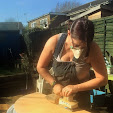I'm not sure to what extent setting is practised outside of the UK, but many schools here practise this. Kids of similar abilities are grouped together in lessons. I won't attempt to explain the reasons for this - I'll leave that to the teachers out there. Let me say, however, that I support the concept. When I could, I tended to practise this myself during my years as a classroom based IT trainer. It reduced the risk of having one person bored out of their skull or totally out of their depth.
Be that all as it may, my younger son recently changed schools due to our house move. The school he now attends has a much stronger academic record than the previous one. At his previous school, he was in the top set for just about every subject. The new school conducted assessments and placed him in the second (of eight) sets for science, which is pretty much what we expected, since this is a very strong subject for him. However, he has been placed in the sixth (of eight) sets for maths, and the bottom sets for French and English. As far as I can tell, there is no setting for the other subjects.
My view is that he should be in the set where he will receive instruction that is appropriate for him. I guess I've grown up enough not to want to be competitive about this and have him in the top set at all costs.
However, I've been mulling over the implications of the disparity. Is it just because the kids at the new school are academically stronger than those of the school he has left? Is it possible that they could be that far advanced? After all, he has been working on the maths curriculum for the year ahead of his for several months, now, and yet he is in the bottom 40% for the subject. Was he in the wrong set in the school he has left? Is the assessment/evaluation process at the new school flawed?
It all remains to be seen. In the meantime, I hope they will allow him to make some input about how well the level of instruction meets his needs in each of his current sets.
Friday, March 14, 2008
Setting
Posted by
Anonymous
at
9:21 am
![]()
Labels: differentiation, formal education
Subscribe to:
Post Comments (Atom)


4 comments:
Karyn, just FYI, what you call setting is known as tracking in the U.S.
However, I'd never heard of having eight tracks for a given subject. Tracks here are often related to a given grade -- e.g., among high school freshmen, there might be three tracks.
Though it's been some time since I had kids in high school.
@Dave Thanks for that, although I think there might be slight differences between setting and tracking. It seems as if, in a given track, the group follows a predetermined path for that track. Whereas, in a set, the teacher has slightly more freedom to do what will work for that set.
For example, in my son's school, there are eight Year 9 (read 9th grade) classes. Instead of staying with their own class groups for maths (for example), they will regroup in their sets for that lesson, so that each teacher is facing a group of around 30 kids who are roughly at the same level, making the extremes of differentiation required less.. well... extreme.
I guess was thinking too much of my own experience, about as useful here as Daniel Boone's.
At first I thought eight sets sounded like a lot, but then I recalled my son's high school class (i.e., year) of some 400, and my daughter's of 700. (We're ambiguous here; we say "my class" both for "the people I have the same homeroom as" and "all the other people who'll graduate the same year as me.")
How large are the various sets?
I recognize the "top set at all costs" frame of mind. Someone once said, "All I want is for my kid to live up to my potential." In some ways it's impossible for people not to take notice of which sets are on top (in terms of difficulty and thus in theory prestige) and which aren't.
But if a student can move freely (enough) between sets for a given subject, and can be in different sets for different subjects, maybe that becomes less important.
@Dave I'm not sure that there is a prescribed size for each set. For example, in the bottom set for French, there are about 60 kids, but because you couldn't lump all those kids together into one class, there are two classes in that set.
I agree that it's a good thing that a child can be in different sets for different subjects - it doesn't really make sense to do anything else, when you think about it.
I'm not sure of the extent to which movement from one set to another is accommodated. I will be discussing that with the form tutor today.
Post a Comment